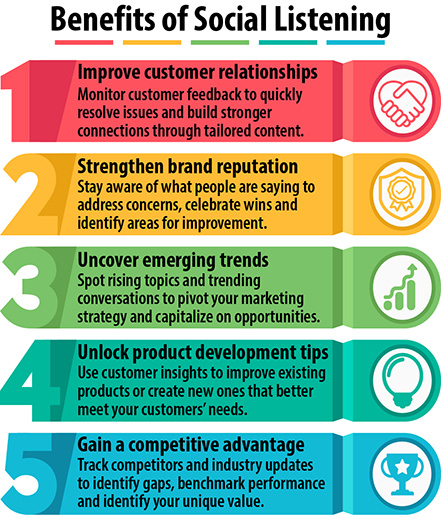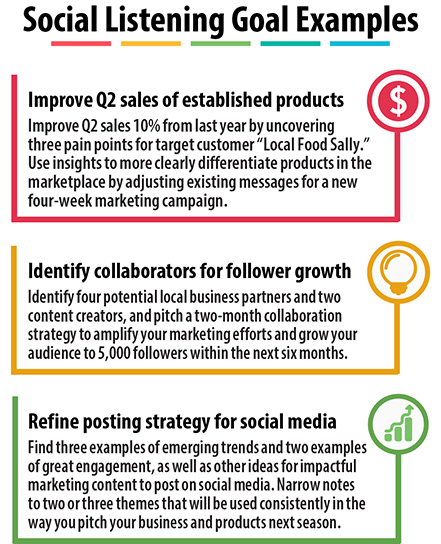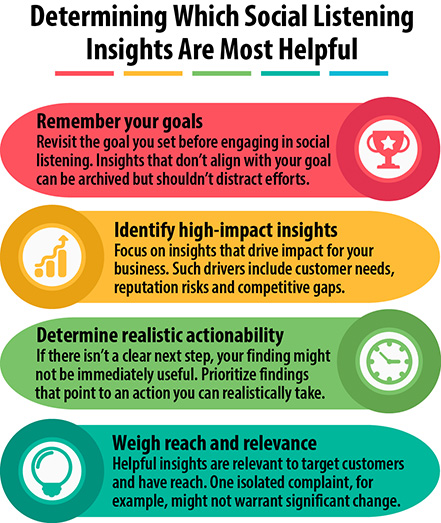Today’s consumers are using online communication platforms to share opinions, ask for recommendations and give feedback on their experiences. For small businesses, this constant stream of digital chatter holds valuable insights into what customers care about, how they feel about brands, and what influences their purchasing behavior.
By engaging in social listening — the act of paying attention to this digital chatter and analyzing it — small business owners can better understand the needs of their target customers and respond in ways that build trust and loyalty (Figure 1). When used strategically, social listening can help businesses leverage social proof and can drive business results such as sales and referrals.

This guide will help you answer five key questions to use social listening and social proof as effective tools in your marketing strategy:
- What is social listening?
- How do I engage in social listening?
- How do I use social listening in my marketing?
- What is social proof?
- How do I use social proof in my marketing?
If your business is new to social media, refer to MU Extension publication G6225, Post, Engage, Grow: A Social Media Primer, to determine what platforms might fit your business and to identify your target audience and build an online following. Refer to MU Extension publication G6229, Harnessing Social Media to Drive Sales, to learn how to use social media to generate sales.
1. What is social listening?
Social listening is the act of tracking and analyzing online conversations, mentions and trends related to your business to gather insights. These insights include details about the needs of your target customers and consumer perceptions your business, as well as valuable data about your competitors and the broader industry, according to Crowdspring’s Ross Kimbarovsky. This digital feedback loop happens whether or not your business is explicitly mentioned, so keeping tabs on all references is crucial. By tuning into what people are saying online, small business owners can gain a clearer understanding of customer opinions, pain points, preferences and expectations. DigitalGuider writer Ryan Clark notes that these insights can improve customer service, guide product development, identify marketing opportunities, and help you connect with customers on a more personal and humanized level.
Social listening goes beyond simply monitoring what people are saying about your brand. It helps you explore why they’re saying it, what they expect from businesses like yours, and where those conversations are occurring. These factors make social listening more expansive than social monitoring, which is focused solely on observing and responding to direct mentions of your business. Put simply, social monitoring is reactive, whereas social listening is strategic. Social listening complements traditional market research tools, such as surveys or focus groups, by providing more organic and real-time feedback from customers in their natural online environments. By combining social listening and other market research efforts, you can gain an in-depth understanding of your market. This understanding can help you build relationships, anticipate trends and gain a competitive edge.
2. How do I engage in social listening?
To get the most out of it, small businesses should engage in social listening regularly because customer sentiments, preferences and behaviors change rapidly. Customer experience platform Konnect Insights asserts that in the fast-moving online world, keeping tabs is critical. There is no ideal frequency for engaging in social listening, but consider committing to a monthly social media and web review to conduct a thorough social listening session.

To benefit the most from social listening, develop a strategy and follow a regular process to keep your findings consistent. Complete the following steps before beginning:
- Clarify your goal and identify what you’re listening for. See example goals in Figure 2.
- Create and monitor Google Alerts for your business name and two to three relevant topics or keywords. Set the alert frequency to “once a week.”
- Create a list of 10 to 15 relevant hashtags, keywords and profiles to check regularly, including those that competitors or potential partners might use.
- Bookmark local community groups and partner pages as well as their social media profiles.
Create a social listening tracker to capture your findings and identify next steps. In the example tracker in Table 1, the business owner is seeking opportunities to grow the business’s online followers and promptly responds to a dissatisfied customer in order to improve sales.
Table 1. Sample social listening tracker for Frank’s Fruits & Vegetables.
| Date | Platform/ source |
Keyword/ hashtag/topic |
Volume/ engagement |
Key profile/ source |
Link | Next step |
|---|---|---|---|---|---|---|
| 9/15 | #FreshWith Franks |
150 likes, 10 comments | Post from user @sweetsbysarah | https://www. facebook.com/ share/p/abcdefg |
Engage with post and repost to followers. | |
| 9/15 | Google Alert | “Frank’s Fruits & Vegetables” | Article from Missouri Life | https://missouri life.com/ storyhere |
Share link on social media and add to website. | |
| 9/15 | LocalHarvest | Frank’s Fruits & Vegetables review | Two-star review, two comments | Review from Jane Doe | https://www. localharvest .org/review .jsp?id=0000 |
Respond to comment and review customer service training for employees. |
| 9/15 | SparkToro | “farmers market near me” | About 4,000 searches each month | Key websites: missourigrown .org and top social accounts including @MOFarmers Markets and @FitFoodie |
Register with Missouri Grown and connect with key social accounts for potential collaborations. |
Complete the following tasks as part of your monthly social listening session:
- Social media scan
- Monitor comments, tags, reviews and messages on your social media platforms using built-in analytics and business manager tools.
- Search untagged mentions of your business or competitors by manually searching each platform.
- Manually search your previously identified list of hashtags, keywords and profiles on each platform.
- Web scan
- Review Google Alerts received related to your business, competitors or topics of interest.
- Visit online forums and communities — such as Reddit, Quora and NextDoor — and consumer review networks to search your business or competitors and monitor feedback.
- Use Google Trends to review the popularity of searches related to your business and topics or keywords of interest.
- Use SparkToro to gain insight into your website visitors and their search habits and demographics, or to search specific keywords.
- Evaluation and reflection
- Review your findings as captured in your social listening tracker, and identify one to two insights to incorporate into future marketing efforts.
- Identify content that could be used in upcoming marketing initiatives as social media reposts, website content, etc.
By using a tool to track social listening efforts, small business owners can benchmark their insights and see change over time. By reviewing monthly insights over the course of multiple seasons, it is possible to see how intentional efforts in social listening are influencing the online conversation about your business.
Artificial intelligence (AI) can streamline social listening by quickly analyzing large volumes of online content to detect sentiment, spot trends, and summarize findings to simplify interpretation. Use of AI saves time and can uncover insights you might otherwise miss. Although not required, AI-powered tools can make your social listening more efficient. However, always check the accuracy of AI-generated results to ensure that data and facts are reported correctly.
3. How do I use social listening in my marketing efforts?

Social listening is an excellent way to identify potential content ideas for your social media platforms and gain deeper understanding of what builds trust with your target customers (Figure 3).
After identifying your customers’ pain points and values, you can build genuine connections by showing empathy, align with their priorities, and crafting content that resonates with them. Some ways to build connections include sharing helpful tips on how to use your products, posting behind-the-scenes stories, or highlighting how your products solve real problems.
Social listening can also alert you to negative feedback or misconceptions about your business. You can respond promptly and mitigate further issues by making product improvements or offering education on how to use your business’s products or services. This proactive approach helps you manage your brand reputation and shows customers that you’re listening and willing to adapt.
Social listening can also identify authentic, organic content to serve as social proof — a marketing concept based on the idea that people are influenced by the actions and opinions of others. Content such as glowing reviews, customer testimonials and user-generated photos can be used strategically across your marketing efforts to build credibility and encourage people to engage with your business.
4. What is social proof?
Recall the last time you bought a vehicle or appliance. Did you read online reviews, ask friends or family for their opinions, or search social media before making a decision? If so, you were influenced by social proof.
Social proof is a psychological phenomenon wherein people observe the actions of others in an effort to adopt the “correct” behavior for a given situation, according to writers at Arizona State University. Essentially, when we’re unsure of what to do, we lean on others for guidance and recommendations.
For small businesses, this behavior plays a significant role in how customers make purchasing decisions. Nearly 70% of online shoppers read between one and six reviews before purchasing, says Koen van Gelder with Statista. Beyond influencing individual buying decisions, social proof offers several benefits to businesses, as it builds credibility quickly, fosters authentic trust, creates curiosity, drives urgency, enhances visibility and awareness, and leverages customer loyalty. Over time, social proof can help your business reach new customers.
There are many forms of social proof; Table 2 focuses on forms that are especially relevant to small businesses in the food and farm sector and how a small business can collect them to strengthen its marketing efforts.
Table 1. Sample social listening tracker for Frank’s Fruits & Vegetables.
| Type of social proof | Description | How to collect via social listening | Other collection methods |
|---|---|---|---|
| Customer reviews or testimonials | Ratings or detailed experiences shared by customers |
|
|
| User-generated content | Photos, videos and stories created by customers or followers featuring your business or products |
|
|
| Endorsements | Validation from industry leaders, recognized experts or content creators |
|
|
| Media mentions and awards | News coverage or awards recognizing your business |
|
|
| Referral programs | Customers recommending your business to others |
|
|
Note that engaging in social listening is an ideal first step to capturing customer reviews or testimonials, user-generated content, media mentions, and awards.
When collecting social proof outside of social listening, look for ways to encourage genuine and meaningful contributions from your followers:
- Include clear calls-to-action that invite customers to leave reviews or share user-generated content.
- Ask for feedback when customers are most satisfied — shortly after a purchase or a positive interaction.
- Engage authentically by responding to reviews, thanking customers for their input, and showing appreciation when they share their experiences.
These small actions build trust, foster community, and encourage others to join the conversation around your business.
5. How do I use social proof in my marketing efforts?
After you have collected examples of social proof, it is important to implement them in your marketing efforts to maximize their impact. Always ensure the social proof you share comes from real customers, followers or other legitimate sources. Using bot-generated or misleading examples can harm your credibility.
To make social proof more engaging and memorable, use visual elements such as images, video and branded graphics. Also, diversify the types of social proof you share to keep content interesting; avoid relying solely on reviews or testimonials, or exclusively reposting user-generated content.
When possible, selectively use social proof that best resonates with your target customer and fits the social platform being used. For example, highlight reviews and testimonials posted by people who match your target customer demographic, and feature endorsements from businesses and creators that your customers already trust and follow. These are some other best practices for using social proof:

- Feature customer testimonials on your business’s website, flyers and paid ads.
- Encourage customers and followers to tag your business or use a branded hashtag in their social media posts, and then repost that content.
- Allow a trusted expert or business to participate in a communications “takeover,” or host a collaborative event to showcase your products or services.
- Display media mentions or awards on your website, and share links of press coverage on social media platforms and newsletters.
- Offer referral incentives or loyalty programs to motivate repeat customers to become ambassadors for your business.
Figure 4 provides an example of how the fictitious Frank’s Fruits & Vegetables implements examples of collected social proof in its marketing efforts.
Summary
Social listening is the act of tracking and analyzing online conversations to gather insights about your target customers, brand, competitors and the broader industry. For small businesses, social listening is a tool that can improve customer relationships, strengthen brand reputation, and unlock product development insights.
To engage in social listening, set a goal and identify key phrases, hashtags, competitors and terms to monitor. Use a tracker similar to the one in Figure 1 to capture and evaluate findings.
Social listening can help small business owners identify content for social proof. Social proof supports sales, builds credibility, creates interest, increases visibility, and taps into customer loyalty.
Resources
This guide uses the sources listed below to explain the concepts of social listening and social proof.
Clark, R. (n.d.). Social Listening: The Ultimate Guide. DigitalGuider.
Kimbarovsky, R. (2025). Social Listening: The Ultimate Guide for Small Business Owners and Marketers. Crowdspring.
Konnect Insights (n.d.). The Psychology Behind Social Listening: Understanding Consumer Behaviour and Motivations. Konnect Insights.
Van Gelder, K. (2023). Number of Reviews Online Shoppers Read Before Making a Purchasing Decision. Statista.
W.P. Carey School of Business. (2007). The Gentle Science of Persuasion, Part Three: Social Proof. Arizona State University.
The authors thank Alaina Boyd and Alyssa Rockers for their review of this publication.
The University of Missouri intends no endorsement of products named in this guide nor criticism of similar products that are not mentioned.